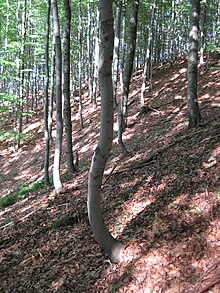Geobotany
The Geobotany is a science in the transition area between botany and geography . The occurrence and spatial distribution of plants and plant communities as well as their changes in the past (vegetation history) are recorded, described and explained . Important auxiliary disciplines Vegetation Science , Site Evaluation and plant sociology .
Geobotany and Plant Geography
As a branch of botany (and thus biology), geobotany researches the effect of space on the spread of vegetation . The investigation here starts with the plants and begins on a small scale.
The corresponding sub-area of biogeography or geography is vegetation geography (phytogeography, plant geography). Here the vegetation is more of interest as a defining feature of geographical areas. In biogeography one starts from the regions of the earth and looks at the topic on a large scale (see flora and vegetation zone ).
The two sciences start from different perspectives, but deal with the same subject: the relationship between plants and geographical spaces. In practice, they can hardly be separated from each other and are often confused outside of the subject areas or taken for the same science. For example, the Duden indicates that the keywords plant geography and phytogeography are synonyms for geobotany .
Descriptive and causal geobotany
The descriptive (descriptive) geobotany can be divided into floristry and vegetation science . Every species and every subspecies in botany, but also every genus and family etc. has a distribution area that can change in the course of their development and under the influence of humans. To determine these distribution areas (areas) is one of the tasks of descriptive geobotany.
Causal geobotany searches for causes and patterns that are decisive for the distribution of plants and plant communities. Important factors that have an influence on the development of plants are the properties of the soil , climate and weather as well as the interactions with microorganisms and animals, often also the effects of humans .
- Examples
Many plants are bound to the occurrence of certain minerals in the soil (e.g. lime plants), need a certain amount of water over the course of the year and have tolerance thresholds for minimum and maximum temperatures. Coherent areas with uniform living conditions can be defined from the distribution of plant species or plant communities.
Plants can also be important indicators of soil movement due to the formation of roots and the curvature and inclination of the trunk. The growth form of the plant in the above-ground area is essentially dependent on the light conditions and the mechanical loads. Important knowledge for assessing slope movements can therefore be obtained from the trunk growth form. The creeping movements of the debris near the surface result in growth anomalies. These can occur, for example, in a curved shape (saber growth) of the trunk (picture).
Neighboring disciplines
The plant ecology studies the relationships between plants and their environment. The autecology relates to the individual , the synecology to the plant population or the plant community.
The findings of climatology are indispensable for biobotany. The classical division of the earth into climatic zones (e.g. tropical, subtropical, boreal) also takes geobotanical aspects into account.
See also
literature
- Wolfgang Frey, Rainer Lösch: Textbook of Geobotany. Plant and vegetation in space and time. 2nd Edition. Spectrum Academic Publishing House , 2004, ISBN 3-8274-1193-9 .
- Richard Pott: General Geobotany - Biogeosystems and Biodiversity. Springerverlag, Heidelberg 2005, ISBN 3-540-23058-0 .
Web links
Individual evidence
- ↑ See Duden online: plant geography , phytogeography , geobotany
- ↑ F. Reuter, J. Klengel, J. Pasek: Ingenieurgeologie. German publishing house for basic industry, Leipzig 1978, p. 191.
